Pronghorn guided hunts offer thrilling adventures, combining challenging pursuits with expert guidance․ These hunts provide unique opportunities to track swift pronghorn antelope, leveraging guides’ deep knowledge and experience for success․
1․1 Overview of Pronghorn Antelope
Pronghorn antelope, often mistaken for goats, are native North American species known for their impressive speed, reaching over 90km/h․ They thrive in open terrains, such as grasslands and deserts, and are recognized by their distinctive horn shape and brownish-tan coats․ Pronghorns are herbivores, feeding on grasses, forbs, and shrubs․ Their large eyes and keen senses make them highly alert to predators․ Despite their name, they are not true antelopes but are unique to the Americas․ Their endurance and agility make them a challenging and rewarding target for hunters, contributing to their popularity in guided hunting experiences․
1․2 Popularity of Guided Hunts
Guided pronghorn hunts have gained significant popularity among hunters due to their high success rates and immersive experiences․ Experienced guides provide valuable insights into pronghorn behavior, habitat, and hunting strategies, increasing the likelihood of a successful hunt․ Additionally, guided tours often include access to private lands, premium gear, and expert tracking skills, enhancing the overall adventure․ The thrill of pursuing such a swift and elusive species attracts both novice and seasoned hunters, making guided hunts a preferred choice for those seeking a memorable and rewarding pronghorn hunting experience․
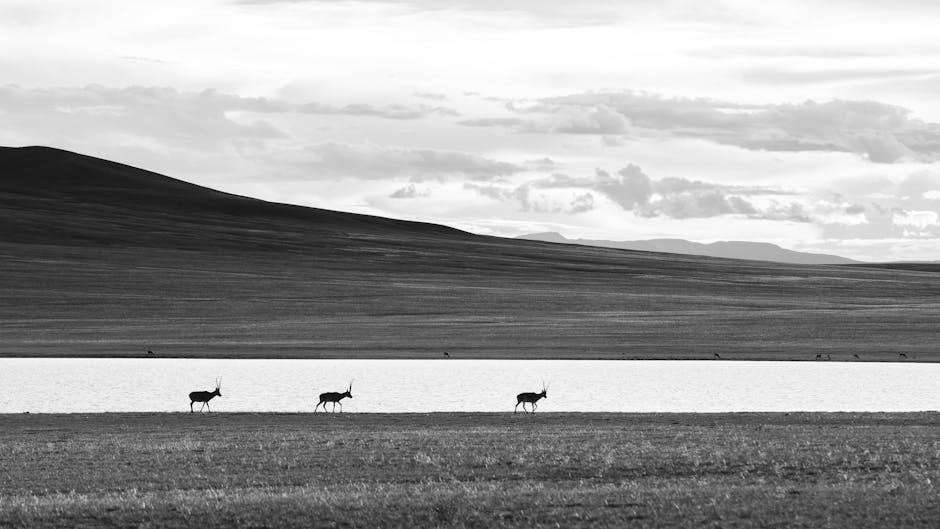
Preparation for a Pronghorn Hunt
Preparation is key for a successful pronghorn hunt, involving physical conditioning, gear readiness, and mental preparation to tackle the challenges of pursuing these swift and elusive animals․
2․1 Physical Conditioning
Physical conditioning is crucial for a successful pronghorn hunt, as it demands endurance to traverse vast, open terrains and keep up with these swift animals․ Hunters should engage in cardio exercises like running or cycling to build stamina․ Strength training is also essential to carry gear over long distances․ Guides often recommend starting a fitness regimen months in advance to ensure readiness․ Proper conditioning not only enhances hunting performance but also reduces the risk of fatigue and injury during the pursuit․ Being physically prepared is key to maximizing the chances of a rewarding experience․
2․2 Gear Preparation
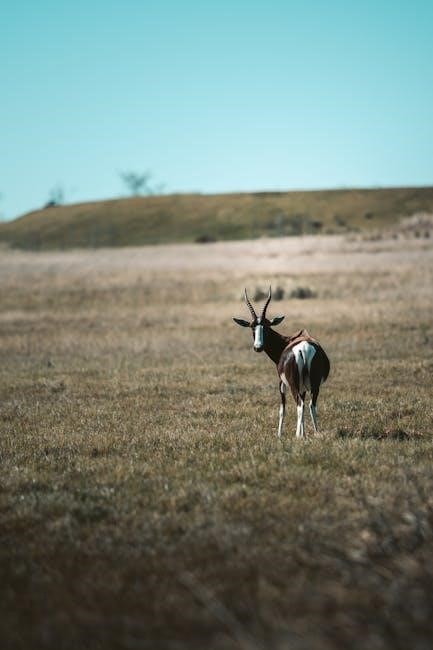
Gear preparation is vital for a successful pronghorn hunt․ Essential items include a high-quality rifle, scope, and binoculars for spotting․ Durable hiking boots and layered clothing are crucial for navigating rugged terrain and varying weather conditions․ A reliable game call, such as the FOXPRO, can mimic pronghorn sounds to attract animals․ Additionally, bring a first-aid kit, water, and snacks for long days in the field․ Guides often provide checklists, but it’s important to test and maintain gear beforehand to ensure functionality․ Proper preparation ensures hunters are ready for the challenges of the hunt and maximizes their chances of success․
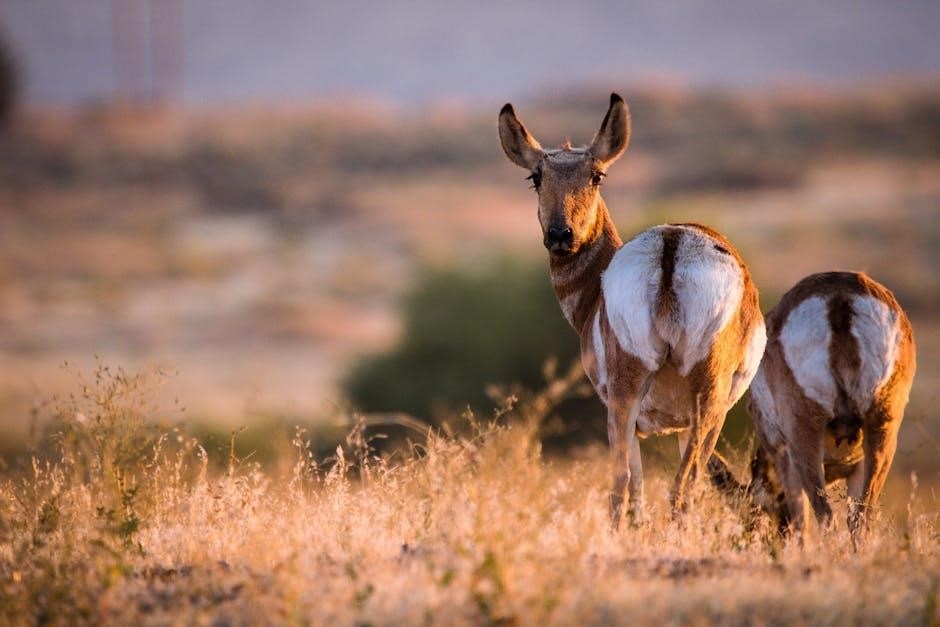
Gear and Equipment
Essential gear includes a high-quality rifle, scope, binoculars, and sturdy boots․ Additional items like game calls, water, and layered clothing ensure readiness for challenging pronghorn hunting conditions․
3․1 Essential Gear List
A high-quality rifle with a reliable scope is crucial for long-range accuracy․ Binoculars are vital for spotting and tracking pronghorns across vast, open landscapes․ Sturdy, comfortable boots are essential for the rigorous terrain․ A lightweight backpack with water, snacks, and extra clothing ensures preparedness for varying weather conditions․ Camouflage attire blends hunters into the environment, increasing chances of a successful stalk․ Additionally, a rangefinder and wind gauge help in precise shot placement, while a first-aid kit and emergency shelter provide safety measures in remote areas․ Each item is selected to enhance both performance and survival․
3․2 Additional Equipment Recommendations
Beyond the essentials, consider a portable game call to mimic pronghorn vocalizations, enhancing stalking effectiveness․ A high-quality rangefinder ensures precise distance measurements, while a wind gauge helps compensate for crosswinds․ A spotting scope provides detailed observations of distant animals․ For comfort, a lightweight, collapsible chair and insect repellent are beneficial․ A water filtration system or portable water purification tablets ensure safe hydration in remote areas․ Lastly, a small, durable camera captures memories, and a GPS device or smartphone with GPS apps aids navigation․ These extras enhance both efficiency and comfort during the hunt․
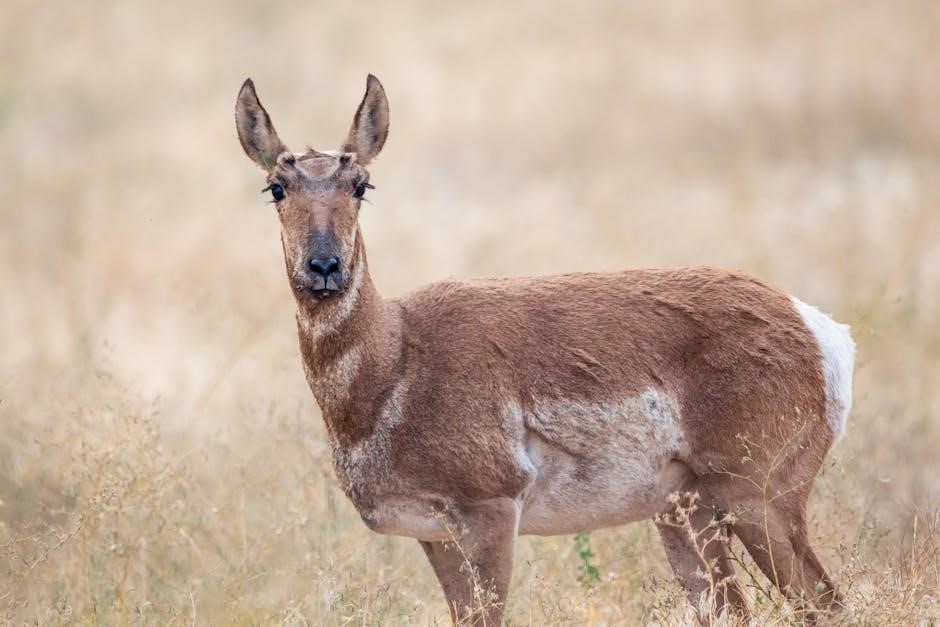
Role of Guides and Outfitters
Guides and outfitters bring expertise, local knowledge, and proven strategies to enhance hunting success․ Their insights ensure a safe, productive, and memorable pronghorn hunting experience for all skill levels․
4․1 Benefits of Hiring a Guide
Hiring a guide for pronghorn hunting offers numerous advantages․ Guides possess extensive knowledge of pronghorn behavior, habitats, and migration patterns, significantly increasing the likelihood of a successful hunt․ They are well-versed in local regulations, ensuring compliance and avoiding legal issues․ Additionally, guides provide access to prime hunting locations, often on private lands, which are not readily available to the public․ Their expertise in tracking and stalking techniques enhances the hunter’s skills and overall experience․ Furthermore, guides handle logistics, allowing hunters to focus solely on the hunt, making the adventure both enjoyable and stress-free․
4․2 Choosing the Right Outfitter
Selecting the right outfitter is crucial for a successful pronghorn hunt․ Research outfitters thoroughly, focusing on their experience, reputation, and success rates․ Ensure they are licensed and have in-depth knowledge of the region․ A reputable outfitter will provide quality equipment, expert guidance, and access to prime hunting areas․ They should also emphasize ethical hunting practices and safety․ Reading reviews and asking for references can help identify reliable outfitters․ A well-chosen outfitter enhances the overall hunting experience, ensuring both success and enjoyment in the field․
Hunting Locations
Pronghorn hunts primarily occur in the American West, with Wyoming, Montana, and New Mexico offering vast, open terrains ideal for spotting and pursuing these swift creatures․
5․1 Popular Hunting States
Wyoming leads as a top pronghorn hunting destination due to its abundant population and expansive public lands; Montana offers prime habitats with rolling hills and open ranges․ New Mexico’s desert landscapes provide challenging yet rewarding hunts․ Arizona and Oregon also host significant pronghorn herds, attracting hunters seeking diverse terrain experiences․ These states’ vast open spaces and regulated hunting programs ensure sustainable pronghorn populations, making them favored locations for guided hunts․ Each state offers unique landscapes, from sagebrush flats to rocky outcrops, enhancing the hunt’s excitement and complexity․
5․2 Public vs․ Private Land Hunting
Public lands, managed by agencies like the BLM, offer accessible hunting opportunities with minimal costs․ However, these areas often require research to locate pronghorn habitats and may involve permits or limited access․ Private lands, while more expensive, provide exclusive rights and often better-managed pronghorn populations, increasing success rates․ Hunters must obtain landowner permission or lease access․ Both options have trade-offs: public lands offer affordability and adventure, while private lands promise solitude and higher chances of harvesting a trophy․ Choosing between them depends on budget, preferred hunting style, and willingness to invest time in scouting․
Hunting Techniques
Pronghorn hunting employs spot-and-stalk methods and strategic calling․ Guides often use game calls to attract animals, while physical endurance and mental focus are crucial for success․
6․1 Spot and Stalk Method
The spot-and-stalk method is a cornerstone of pronghorn hunting, requiring patience and precision․ Hunters use binoculars to locate herds from a distance, then move stealthily to close the gap․ This approach demands excellent physical conditioning and the ability to navigate challenging terrain, often under the scorching sun․ Guides play a crucial role, helping hunters identify the best vantage points and strategies to get within shooting range․ The method relies heavily on wind direction and cover, making it both a test of skill and a thrilling experience in the open landscapes․
6․2 Calling Techniques
Calling techniques are a strategic tool in pronghorn hunting, often used to lure animals closer․ Guides employ specialized calls, such as fawn bleats or buck grunts, to mimic pronghorn communication․ These sounds attract curious bucks, especially during mating season․ Electronic callers like FOXPRO are popular, offering realistic and varied sounds․ Timing and realism are key; overcalling can alarm pronghorns․ Guides help hunters master these methods, ensuring effective and ethical use of calling to enhance the hunting experience in the vast, open habitats where pronghorns thrive;
Regulations and Licenses
Regulations and licenses are crucial for legal pronghorn hunting․ Ensure compliance with state-specific permits, tags, and season dates to avoid penalties and support conservation efforts effectively․
7․1 Licensing Requirements
Obtaining the proper licenses is essential for pronghorn hunting․ Requirements vary by state, with residents and non-residents often needing different permits․ Tags and stamps are typically mandatory, ensuring legal compliance․ Applications must be submitted by specific deadlines, and hunter education certifications may be required․ Additionally, some states use point systems to allocate tags fairly․ Licensing fees contribute to conservation efforts, supporting pronghorn populations and habitat preservation․ Always verify local regulations to avoid penalties and ensure a lawful hunting experience․
7․2 Bag Limits and Seasonal Restrictions
Bag limits and seasonal restrictions are crucial for sustainable pronghorn hunting․ Typically, hunters are allowed one animal per season, with strict enforcement to prevent overharvesting․ Seasons are carefully timed to avoid disrupting mating or fawning periods, ensuring healthy population dynamics․ Some states implement limited tags to manage hunting pressure, balancing recreational opportunities with conservation goals․ Adherence to these regulations is vital for maintaining robust pronghorn herds and preserving the ecosystem․ Hunters must familiarize themselves with local rules to comply and support long-term wildlife sustainability․
Conservation Efforts
Conservation efforts are vital for pronghorn sustainability․ Initiatives include habitat restoration and wildlife management, ensuring healthy populations and ecosystems for future generations of hunters and wildlife enthusiasts․
8․1 Role of Hunting in Conservation
Hunting plays a critical role in pronghorn conservation by generating funds and promoting sustainable wildlife management․ Revenue from licenses supports habitat preservation and research, ensuring pronghorn thrive․ Additionally, regulated hunting helps maintain balanced populations, reducing competition for resources and preventing overgrazing․ This aligns with broader conservation goals, fostering healthy ecosystems․ Hunters contribute directly to these efforts, making their participation essential for long-term pronghorn survival and environmental health․ Conservation through hunting is a proven model, benefiting both wildlife and the communities involved in their management․
8․2 Habitat Preservation Initiatives
Habitat preservation is vital for pronghorn survival, focusing on protecting open landscapes and migration corridors․ Initiatives include partnerships between public and private lands to ensure continuous habitats․ Grazing management practices and restoration projects aim to maintain healthy vegetation and water sources․ These efforts counter threats like habitat fragmentation and climate change․ Conservation organizations collaborate with landowners to implement sustainable practices, ensuring pronghorn can thrive․ Preserving natural habitats not only benefits pronghorn but also supports biodiversity and ecosystem balance, making it a cornerstone of long-term wildlife conservation strategies․
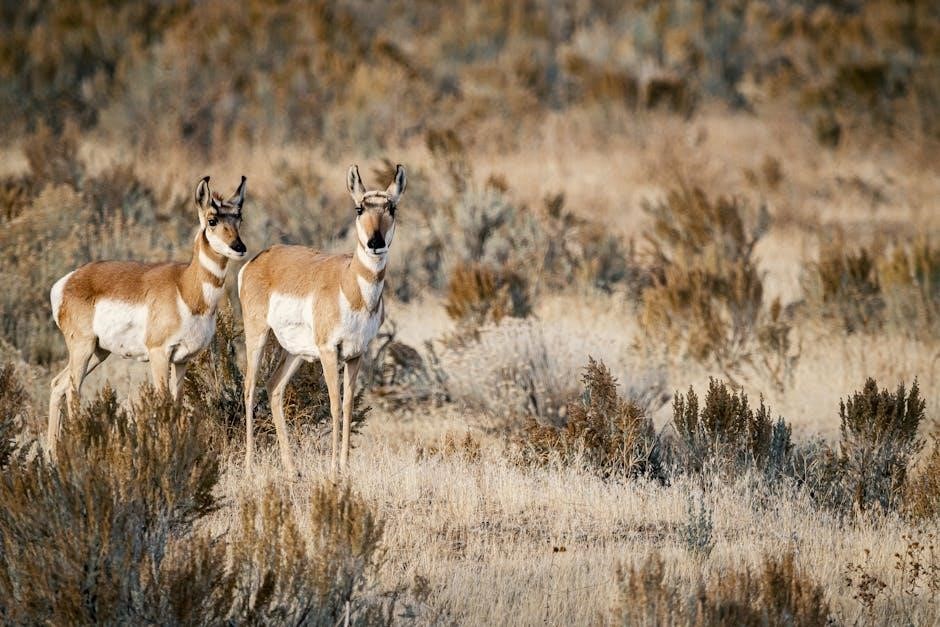
Physical and Mental Challenges
Pronghorn hunts demand stamina, endurance, and mental focus․ The pursuit of swift antelope across vast, rugged terrain tests physical limits and requires sharp concentration for success․
9․1 Endurance Requirements
Hunting pronghorns requires immense physical endurance due to the species’ remarkable speed and agility․ Participants must be prepared for long-distance treks across challenging terrains, often under harsh weather conditions․ The antelope’s ability to sprint at speeds over 90 km/h makes pursuits demanding․ Hunters need strong cardiovascular fitness and stamina to keep up with guides and maintain focus during extended periods․ Proper training and conditioning are essential to handle the rigors of the hunt effectively․ Mental resilience complements physical endurance, ensuring hunters stay determined and composed throughout the challenging pursuit․
9․2 Mental Preparation Strategies
Mental preparation is crucial for pronghorn hunting, as it demands focus, patience, and resilience․ Hunters should practice visualization techniques to anticipate scenarios and stay calm under pressure․ Mindfulness exercises can help maintain concentration during long treks and stalking․ Building a positive mindset is key to overcoming challenges like harsh weather or missed opportunities․ Additionally, understanding the role of guides and trusting their expertise can boost confidence․ Mental strategies, such as setting realistic goals and embracing the journey, enhance overall hunting success and satisfaction in this demanding yet rewarding pursuit․
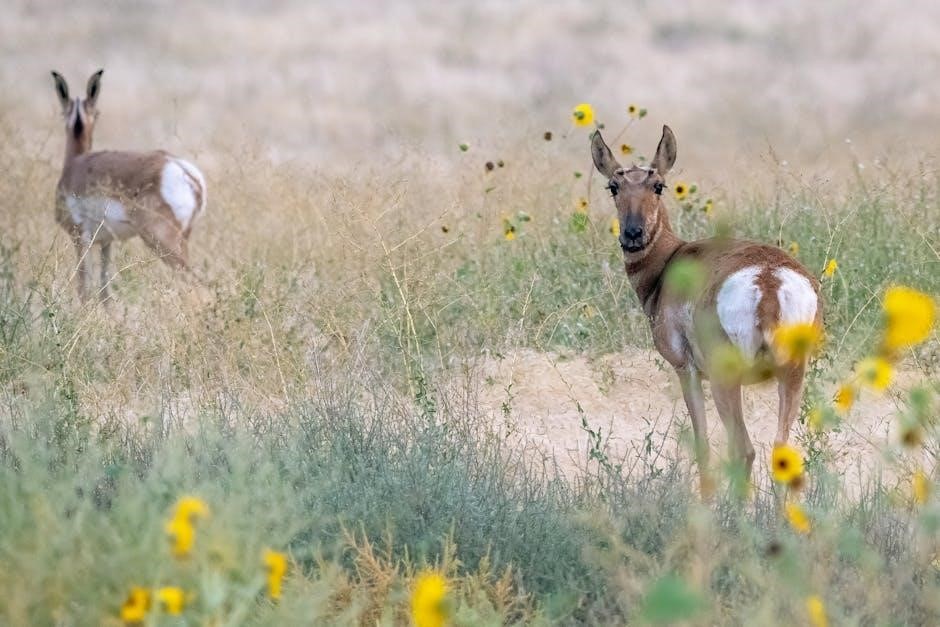
Booking a Guided Hunt
Booking a pronghorn guided hunt involves thorough research, understanding costs, and selecting reputable outfitters․ Plan meticulously to ensure a well-organized and successful hunting experience with expert guidance․
10․1 Researching Outfitters
Researching pronghorn guided hunt outfitters requires careful evaluation of their experience, success rates, and reputation․ Look for reviews, ask for references, and inquire about their knowledge of local terrains and regulations․ Ensure they are licensed and have a track record of safe, ethical hunting practices․ A reputable outfitter will provide detailed information on what to expect, including gear requirements and terrain challenges․ Their expertise can significantly enhance your hunting experience, so thorough research is essential to make an informed decision․ Additionally, consider their familiarity with the specific species and habitat to maximize your chances of success․ Prioritize outfitters who emphasize conservation and sustainable hunting practices․ Always verify their credentials and ask about their guiding philosophy to align with your hunting goals and values․ By doing your due diligence, you can select an outfitter who meets your needs and ensures a memorable hunt․ This step is crucial for a successful and enjoyable pronghorn hunting adventure․
10․2 Understanding Costs and Packages
Understanding the costs and packages for pronghorn guided hunts is crucial for planning your adventure․ Prices vary based on factors like location, duration, and services included․ Basic packages may cover guiding and permits, while premium options include meals, lodging, and gear․ Ensure you inquire about what’s included and any additional fees․ Some outfitters offer all-inclusive deals, simplifying budgeting․ Always ask for a detailed breakdown to avoid surprises․ Comparing packages from different outfitters can help you find the best value for your money․ Clarify if taxes, licenses, or gratuities are extra․ Transparent pricing ensures a stress-free hunting experience․ Prioritize your needs to choose the right package․
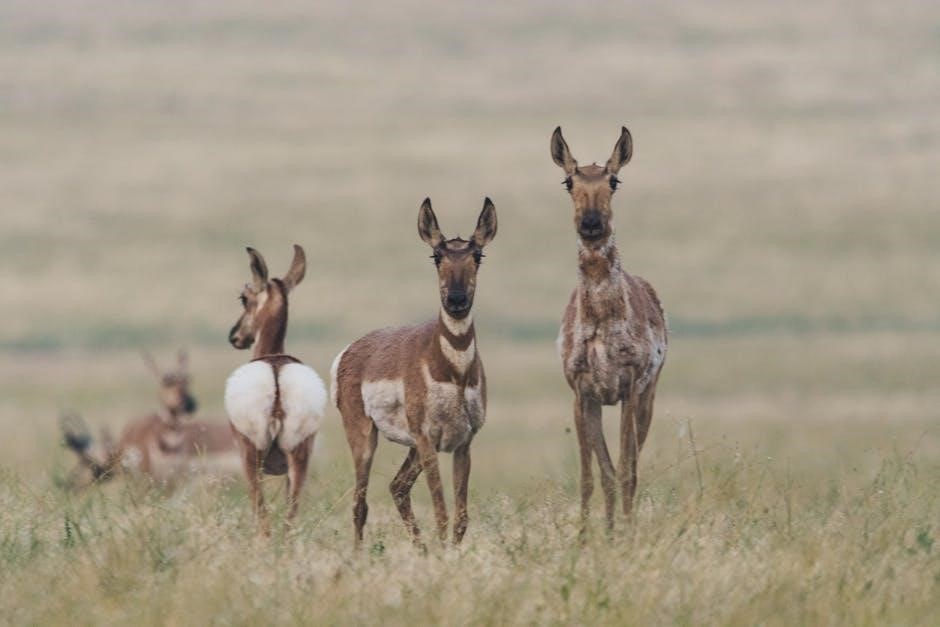
Post-Hunt Processing
Post-hunt processing involves field dressing, transporting, and handling pronghorn meat and trophies․ Guides often assist with these steps to ensure quality preservation for taxidermy and consumption․ Proper techniques are essential․
11․1 Field Dressing and Handling
Field dressing and handling are critical steps after a successful pronghorn hunt․ Guides often assist in quickly and humanely processing the animal to maintain meat quality․ Proper techniques involve making precise cuts to avoid contamination and ensure the carcass cools rapidly․ Handling with care prevents spoilage and preserves the integrity of the hide for taxidermy․ Using sharp knives and the right tools is essential for a clean and efficient process․ Following ethical practices ensures respect for the animal and adherence to hunting traditions․ Proper field dressing and handling are vital for both immediate consumption and long-term preservation of the harvest․
11․2 Taxidermy and Meat Processing Options
Taxidermy and meat processing are key considerations after a successful pronghorn hunt․ For those wanting to preserve their trophy, professional taxidermists offer custom mounts, hides, or life-like poses․ Meat processing options vary, with many hunters opting for expert butchers to craft tender steaks, ground meat, or jerky․ Proper handling ensures the venison remains flavorful and safe to eat․ Some hunters also choose to donate excess meat to wildlife programs or local communities․ These options allow hunters to fully utilize their harvest while celebrating their achievement with lasting mementos or delicious meals․
Pronghorn guided hunts offer an unforgettable experience, combining thrilling chases with expert guidance․ Conservation efforts ensure sustainability, making each hunt a contribution to wildlife preservation․ Embark on your adventure today for memories and challenges that last a lifetime!
12․1 Final Thoughts on Pronghorn Hunts
Pronghorn hunts are a unique blend of challenge and reward, offering hunters an opportunity to connect with nature and test their skills․ The swift and elusive nature of pronghorn antelope makes each hunt an exhilarating adventure․ With the right preparation and guidance, hunters can successfully harvest these magnificent creatures while contributing to conservation efforts․ The experience fosters a deep appreciation for wildlife and the outdoors, creating lasting memories for those who embark on this thrilling journey․
12․2 Encouragement for Future Hunters
Embarking on a pronghorn hunt is a rewarding experience, offering personal growth and unforgettable moments․ For future hunters, the challenge of pursuing these swift creatures is an opportunity to develop patience, skill, and a deeper connection with nature․ With proper preparation and guidance, newcomers can successfully navigate the world of pronghorn hunting while contributing to conservation․ The thrill of the hunt and the camaraderie with guides and fellow hunters create a fulfilling adventure that inspires a lifelong passion for the outdoors and wildlife stewardship․
